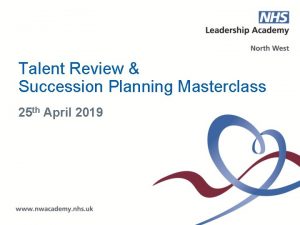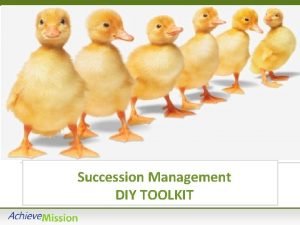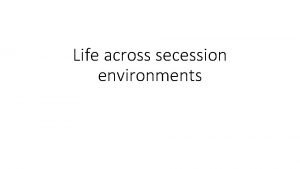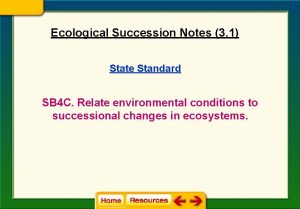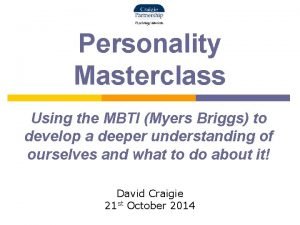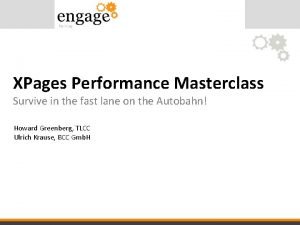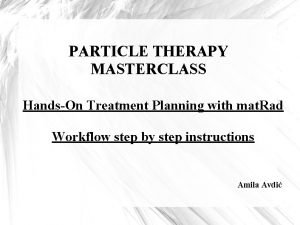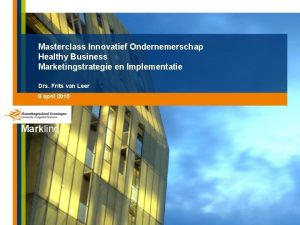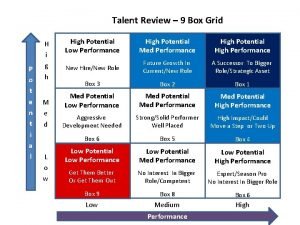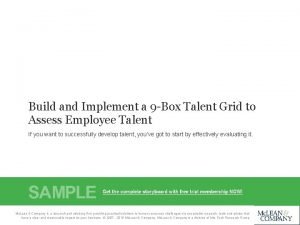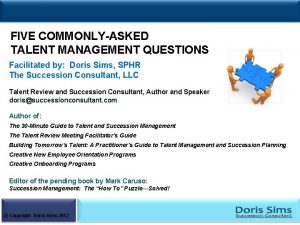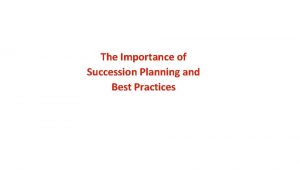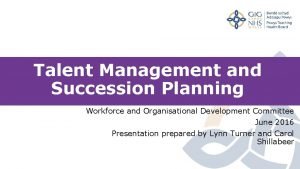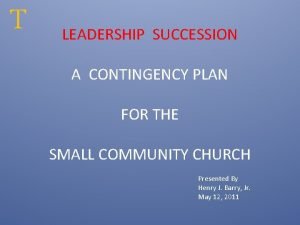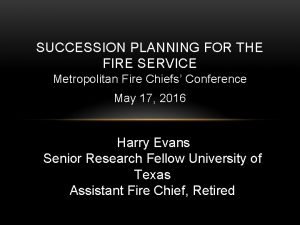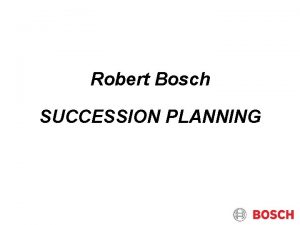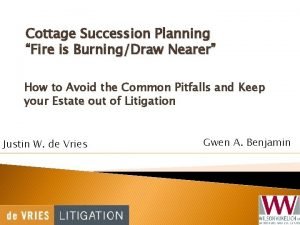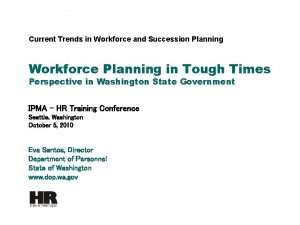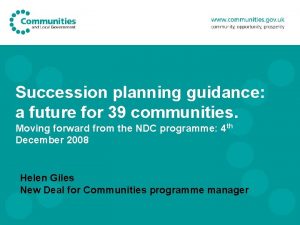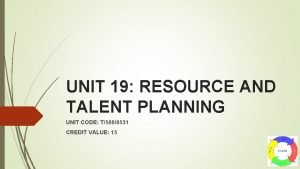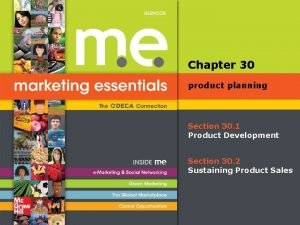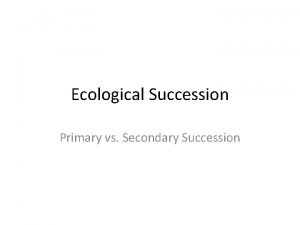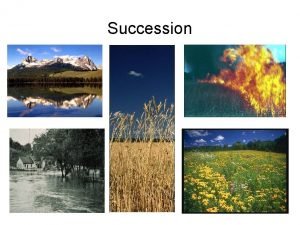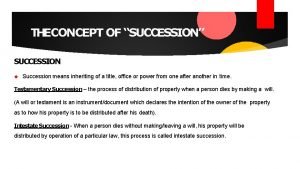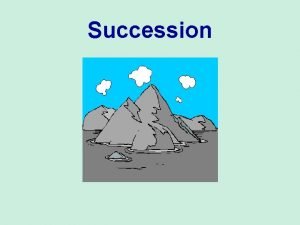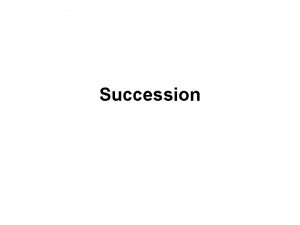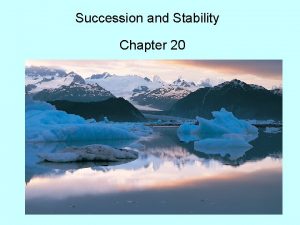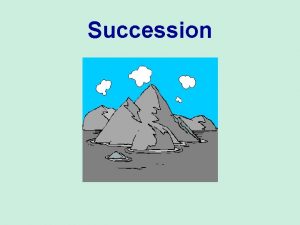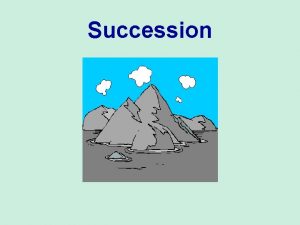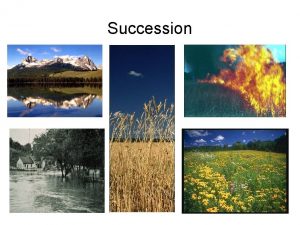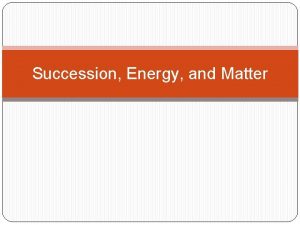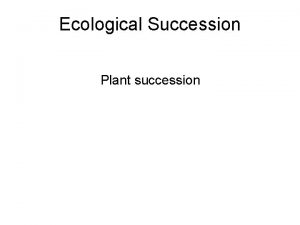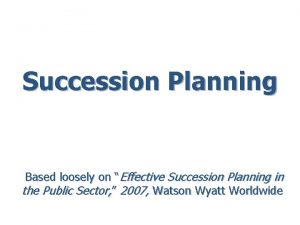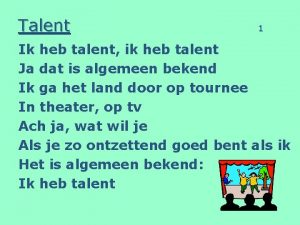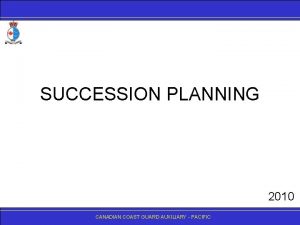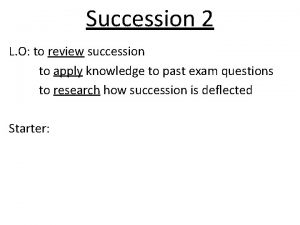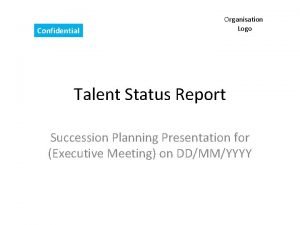Talent Review Succession Planning Masterclass 25 th April













































- Slides: 45

Talent Review & Succession Planning Masterclass 25 th April 2019

Agenda • Develop a deeper understanding of the strategic and regulatory requirements relating to Talent Management • Consider the critical data essential to carrying out Talent Reviews and Succession Planning successfully • Exploring Talent Review and Succession Planning cycles and associated tools • Creating the right conditions for Talent Review • Participate in a Talent Review simulation • Reflect on the days’ experiences and learning to take away

Introductions • Your name, role and organisation • Experience of talent review and succession planning • One thing you’d like to get from today

Developing People: Improving Care • Developed by health and care partners, published in December 2016 and backed by regulators and inspectors • Main purpose: to equip NHS funded organisations to deliver continuous improvement in local health and care systems and to encourage development of a critical set of improvement and leadership capabilities among staff • Critical capabilities: - Systems leadership skills - Improvement skills - Compassionate, inclusive leadership skills - Talent management

What is the ask? All NHS funded organisations: • Leadership, talent development and planning are core strategic activities • Develop your own leadership and talent development strategies HEE: • Support organisations to do TM better • Establish pilot TM forums at regional and local system levels • Drive local talent development strategies and sustainable succession planning

Well Led Framework Published in June 2017, strengthening content on leadership, culture, system working and quality improvement • • • Strategic approach to managing talent Leadership strategy and succession plan Flexible, agile responses to change Participation in pooled activity including local area talent planning Emphasis on partnership/system working

Regional Talent Boards Primary aims: • Clear visibility of current and future talent at sub-Board level • A better understanding of the profile of and demand for emerging talent pipeline across the region • Acting as ‘One NHS’ in relation to talent • Streamlined approach for identifying , assessing and in the future, mobilising talent

Talent review purpose • To encourage people to maximise their performance and potential, and tailor development interventions that are specific to their needs – individual • To inform the organisations succession plan, based on robust information – organisation • Readiness to participate in system and regional talent management interventions

Talent cycle

A whole organisation approach

Benefits and opportunities • • Driver of culture change Identify and address gaps Tailored development Increases attraction, engagement and retention Improved patient care Accelerates delivery of business plans Enhances succession planning

Talent review overview • Preparation • Review • Feedback and action

Talent review information • Key achievements • Delivery of objectives • Demonstration of values/behaviours • Agility • Stretch behaviours • Appetite/Motivation Performance Potential Aspirations Readiness • • Strengths • Career goals • Next steps • • Happy what I’m doing Ready Now / not ready 6 – 12 months 1 – 2 years etc.

Review considerations • Briefing • Ground rules – CAPES: confidentiality, avoid bias, be present, use evidence, sold! • Conflicts of interest

A framework for review STEP 1: Facilitator positions the session and steers discussion STEP 2: Line Manager provides brief overview, view and rationale STEP 3: Contributors ask questions, Line Manager responds STEP 4: Contributors provide their evidence/examples STEP 5: Facilitation of decisions about development, succession and feedback STEP 6: Facilitator sums up and captures outputs/decisions about development, succession and feedback

Break

Talent Pipelines • Passages/transitions • New ways of working • Leaving the old behind - skills requirements - time applications - work values

Development and Support

Feedback • Consequences of closing/not closing the loop • Feedback within 2 weeks of the review • Two way conversation – coaching approach

Quality of relationships

Sources of error • • Halo and horns Leniency Harshness First impressions Recency Stereotyping Rushed decision making Similarity/attractiveness

Bias • Views and opinions that we are unaware of, yet are automatically activated and frequently affect our everyday behaviour and decision making. • Our unconscious biases are influenced by our background, culture, context and personal experiences (Atewologun, Cornish & Tresh, 2018) • We are hard wired to use lenses or filters we use to view the world, hence the need to focus on conscious decision-making that relies less on our assumptions

Triggers • • • When we are hurrying to make a decision When we are under pressure When we need to access/surmise information quickly When we are overloaded or tired When we are nervous, unsure, lack confidence When we see or hear specific characteristics or behaviours that confirms what we already ‘know’ to be true When is my bias most likely to be triggered? When may I need to pay extra attention to conscious decisionmaking?

Other indicators • • • Facial expressions Tone of voice Hand gestures Choice of behaviours Questions & interactions Eye contact Where you sit, how you greet, where you look, who you ask, when you interrupt, how you challenge, and how you do nothing - all tell a story!

Further information • Harvard IAT https: //implicit. harvard. edu/implicit/uk/takeatest. html • RTB Highlight Report on Diversity & Inclusion Assurance • https: //www. ted. com/talks/yassmin_abdel_magied_what_does_my_he adscarf_mean_to_you? language=en is a short excellent video on bias

Succession Approaches Should be done based on two-way talent conversations More often done in splendid isolation (or not at all) Can be considered from different perspectives • • • Top roles Replacement at different levels Critical roles Leadership development Technical competency

Succession Plans

Succession Risks Capturing risks • • Role title Description Action to be taken Who is responsible for the action and by when Mitigating actions • • Temporary solutions Long term solutions Recruitment implications Structural/role changes?

Succession Tips • • • Be transparent Define which roles/services you are looking at Explain why Use a simple template Capture risks and actions to mitigate them

Lunch

Simulation – Set Up Working in three groups, each with: • 1 x Facilitator • 2 x Line managers – one Chief Nurse, one Finance Director • 2 x Executive Team contributors - one Chief Operating Officer, one Medical Director

Simulation - Pack • • Summary of roles and responsibilities Agenda Rating criteria Profiles x 4 Issued separately • Information to underpin your (fictional) views …

Simulation - Roles • Facilitators – chair and manage the structure of the review, manage time, ensure feedback and outcomes are captured, support and challenge as appropriate • Line managers – present information on individuals from your team as a manager, answer questions, support and challenge as a contributor as appropriate • Executive Team contributors – share insights and evidence you have about individuals being reviewed, ask questions, support and challenge as a contributor as appropriate

Simulation - Agenda • Scene setting/set up (facilitator) - 5 mins • Review Profile 1 - 20 mins • Review Profile 2 - 20 mins • Review Profile 4 - 20 mins • Review Profile 5 - 20 mins • Summing up - 20 mins • Group Reflections - 15 mins Break

Simulation – Rating Criteria Performance Low Operating below required level, not meeting objectives (and behaviours) either on time or to required standard Medium Operating at required level, consistently meeting the majority of objectives (and behaviours) the majority of the time High Operating above required level, exceeding the requirements/expectations in relation to objectives (and behaviours) Potential Low At this point in time the individual is not displaying the potential and/or motivation to move into a different role Medium At this point in time the individual is displaying moderate potential and/or motivation to move into a different role High At this point in time the individual is displaying the high levels of potential and motivation required to move into a more challenging (leadership) role

Simulation profiles • 2 x Deputy Nurse Directors • 1 x Deputy Director of Finance • 1 x Deputy Director of Performance and Strategy Line Managers: read your profiles and be prepared to talk about the performance, potential, aspirations and readiness of your reports, along with further support they may require and your view on them as a potential successor Contributors: read through all the profiles and be prepared to share your experience of working with the individuals being discussed, along with your view on them as a potential successor and support/development you believe would be helpful to them

Simulation Flow - Recap STEP 1: Facilitator positions the session and steers discussion STEP 2: Line Manager provides brief overview, view and rationale STEP 3: Contributors ask questions, Line Manager responds STEP 4: Contributors provide their evidence/examples STEP 5: Facilitation of decisions about development, succession and feedback STEP 6: Facilitator sums up and captures outputs/decisions about development, succession and feedback

Capturing the outputs Best practice: • Managers capture feedback about their own direct reports OR • Managers take notes about their direct reports throughout discussion so they can add to feedback captured by others

Simulation Part 1 • Scene setting/set up (facilitator) • Review Profile 1 • Review Profile 2

Break

Simulation Part 2 • Review Profile 3 • Review Profile 4 • Ensure your succession plan and feedback summaries are complete • Group reflections/questions

Group reflections • Sharing results and observations • Feedback from facilitators, line managers and contributors • What worked well? • What worked less well? • What would you do differently?

Your questions Please share your main take away from today

Evaluation • Quick questionnaire • We would welcome your view on: �What worked well �What worked less well/what would you change? �What would it be helpful to have more of?

Thank you
 Talent review succession planning
Talent review succession planning Talent review chart
Talent review chart Ecological succession succession of a pond
Ecological succession succession of a pond Ecological succession succession of a pond
Ecological succession succession of a pond Masterclass of personality
Masterclass of personality Masterclass gastgerichtheid
Masterclass gastgerichtheid Fastlane concat string
Fastlane concat string Tom wang masterclass
Tom wang masterclass Particle therapy masterclass
Particle therapy masterclass Masterclass informatiebeveiliging
Masterclass informatiebeveiliging Technical analysis masterclass
Technical analysis masterclass Masterclass directing
Masterclass directing Royal institution maths masterclasses
Royal institution maths masterclasses Particle therapy masterclass
Particle therapy masterclass Branchekrachten
Branchekrachten Sleep masterclass
Sleep masterclass 9 block talent review
9 block talent review Maureen potts
Maureen potts 9 box talent assessment
9 box talent assessment Talent management questions
Talent management questions Ibm succession planning
Ibm succession planning Cipd succession planning
Cipd succession planning Succession planning for church leaders
Succession planning for church leaders Succession
Succession Diversified succession plan
Diversified succession plan Types of succession planning
Types of succession planning Cottage succession planning
Cottage succession planning Succession planning definition
Succession planning definition Succession planning trends
Succession planning trends Succession planning guidance
Succession planning guidance Resource and talent planning
Resource and talent planning Chapter review motion part a vocabulary review answer key
Chapter review motion part a vocabulary review answer key Ap gov final review
Ap gov final review Narrative review vs systematic review
Narrative review vs systematic review Search strategy example
Search strategy example Narrative review vs systematic review
Narrative review vs systematic review Seven steps of product development
Seven steps of product development Strategic planning vs tactical planning
Strategic planning vs tactical planning Planning balance sheet in urban planning
Planning balance sheet in urban planning Scenario planning workforce planning
Scenario planning workforce planning Proactive planning and reactive planning
Proactive planning and reactive planning Perencanaan agregat
Perencanaan agregat Short, medium and long term planning in education
Short, medium and long term planning in education Language planning and policy slideshare
Language planning and policy slideshare Aggregate capacity planning
Aggregate capacity planning Aggregate planning is capacity planning for
Aggregate planning is capacity planning for
